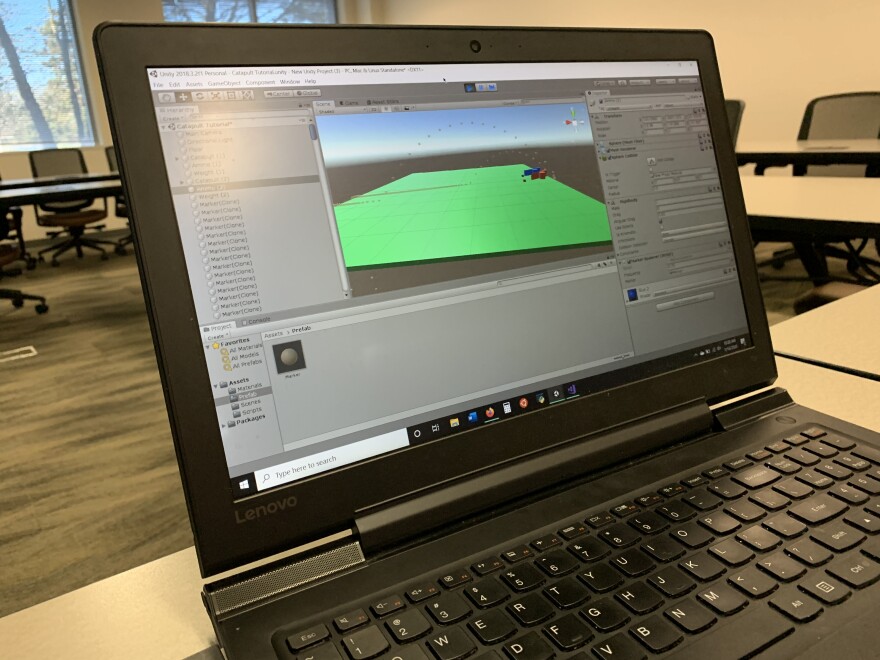A group of teachers hold their phone in front of their faces. Using the camera they’re looking at the classroom they’re standing in...when suddenly a zombie appears. It warns they need to reach a safe house or they’ll be eaten alive.
With that they face a series of locked doors. To open them and escape the undead’s grasp, they need to answer a series of vocabulary questions. Wait, what?
This is an augmented reality game about zombies, yes. But it’s also a language arts lesson for middle school students.
This session was part of the “STEAMing It Up” conference at Northern Illinois University.
If you don’t know what Augmented (AR) or Virtual Reality (VR) means or what the difference is, here’s a breakdown: Virtual Reality is when you put on a headset or glasses that drops you into a new 3-dimensional world.

Augmented reality is when a device or app alters your perception of your world. Think of the popular mobile game Pokémon GO. The pocket monsters you want to capture pop up on your phone screen, scampering across your yard or wherever your phone camera is pointed.
Hal Brynteson is an undergraduate researcher at NIU who helped present on AR.
“It's sometimes difficult to think of uses technology besides like, ‘Oh, that's cool,’” said Brynteson. “Especially in education, what are students actually gaining from seeing the ocean in a VR headset? What can we measure? What can we create that’s new with these experiences?”
That question is the crux of this conference.
Stacie O’Daniell teaches business education and technology at Genoa-Kingston High School. This is her first year in the classroomafter years as an education administrator in the private sector.
O’Daniell knows she has catching up to do, especially when it comes to new tech.
And she hopes conferences like this one can help her learn more to keep up with their students.
O’Daniell attended another AR/VR workshop in the fall.
“I took it back to my students and they taught me. They like to research what’s out there, and they brought those applications back to me. And that's how we move forward with it. So it really was a student-led project,” said O’Daniell.
She started integrating the AR/VR lessons with her school’s computer club first.
“They really like the science ones where they can look at the human body and focus in on different parts and see how what each part does and how it relates to another part that's been a big hit,” she said.

Just being introduced to the concepts and platforms is useful, especially as AR/VR becomes more mainstream.
While Genoa-Kingston students explore that, surgeons at Stanford University Medical Center use 3-D models in VR to simulate surgeries. They use images from their actual patient to map their strategy before they break any skin.
“The education system has to change, and we have to meet these kids where they're at,” said O’Daniell. “For example, the AR/VR, kids are learning through this and we're meeting them where their skill sets are, instead of trying to put them in our box.”
But collaboration isn’t limited to conferences, it’s also online. Hal Brynteson says Metaverse, the augmented reality app the teachers used, is a great example.
“Another reason we chose Metaverse is it already has an existing online teacher community. So, you can look up and browse through different games,” said Brynteson.
Matthew Swed is an undergraduate researcher studying applied mathematics at NIU. In another session, he gave educators the basics of Unity. It’s a software engine used to build video games.
“I just want to kind of go through it a bit, so that you're not completely overwhelmed.”
Swed built a makeshift catapult in the software’s 3-D space. Then he dropped a weight on it and launches a ball across the screen.
“You could go in and have the kids see what happens if you made the weight to be like 75, instead of 50, or you could go to the ammo and you could change the weight of the ammo and see how that affects the path of it or you could change the weight of the catapult even.”
The software gives the tools to learn how to build video games with little to no prior coding experience.

“Kids physics class could create simulations?” asks one of the teachers. “Oh, yeah. But you can also do better than this,” said Swed.
Luckily, like Metaverse, there’s an online ecosystem in place to help you learn. Students and teachers can find step-by-step tutorials, quick recipes for simple games.
“As a high school student, if you had handed me this software, a bunch of videos and said, ‘this is how video games are made.’ I wouldn't have even needed a classroom setting, I would have just taken it on my own initiative and taking time to learn all of this stuff.”
Stacie O’Daniell hopes to inspire that kind of curiosity when she takes the tools back to her classroom for the next generation of programmers, engineers and artists.




